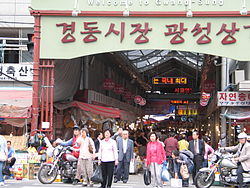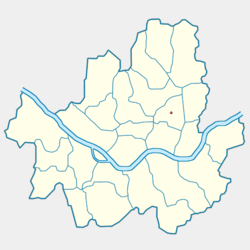- Dongdaemun-gu
-
Dongdaemun-gu — District — 동대문구 · 東大門區 Gyeongdong Market Location of Dongdaemun-gu in Seoul Country South Korea Region Sudogwon Special City Seoul Administrative dong 26 Government - Mayor Hong Sa-rip (홍사립) Area - Total 14.22 km2 (5.5 sq mi) Population (2010[1]) - Total 346,770 - Density 24,386.1/km2 (63,159.6/sq mi) Time zone Korea Standard Time (UTC+9) Website Dongdaemun-gu official website Dongdaemun-gu is one of the 25 gu (districts) of Seoul, South Korea. It is located to the north of the River Han. Its district office is in Yongdu-dong where is close to the underground station of branch of Line 2.
The mayor of this district is Sarip Hong (홍사립) since July 2006.
Contents
History
Dongdaemun-gu was first created in 1943 when the "gu" system started and was larger in area than today. Seongbuk-gu separated from the district in 1949, and Changsin Dong and Sungin Dong were given to Jongno-gu in 1975. An additional 17 dong (neighborhoods) separated to become Jungnang-gu in 1988.[2]
Administrative divisions
Dongdaemun-gu currently comprises 22 dong from August 11, 2008.
- Cheongnyangni-dong
- Dapsimni 1-dong
- Dapsimni 2-dong
- Dapsimni 3-dong
- Dapsimni 4-dong
- Hoegi-dong
- Hwigyeong 1-dong
- Hwigyeong 2-dong
- Imun 1-dong
- Imun 2-dong
- Imun 3-dong
- Jangan 1-dong
- Jangan 2-dong
- Jangan 3-dong
- Jangan 4-dong
- Jegi 1-dong
- Jegi 2-dong
- Jeonnong 1-dong
- Jeonnong 2-dong
- Jeonnong 3-dong
- Sinseol-dong
- Yongdu-dong
Transportation
Underground
- KORAIL(Korean Railway) and Seoul Metro
-
-
- (Jongno-gu) ← Sinseol-dong — Jegi-dong — Cheongnyangni — Hoegi — Hankuk University of Foreign Studies — Sinimun → (Seongbuk-gu)
-
-
-
- Sinseol-dong — Yongdu → (Seongdong-gu)
-
-
-
- (Seongdong-gu) ← Dapsimni — Janghanpyeong → (Gwangjin-gu)
-
- KORAIL(Korean Railway)
Geography
Dongdaemun Gu borders Seongbuk-gu to the north-west, Jungnang-gu to the east (with the Jungnangcheon stream forming the border), Gwangjin-gu to the south-east, Seongdong-gu to the south, meets Jung-gu at a point in the south-west and borders Jongno-gu to the west. The busiest neighbourhood of the district is the Cheongnyangni area - a large commercial zone formed around Cheongnyangni Station, one of the secondary CBDs of Seoul. Dongdaemun Gu is named after the east gate in Seoul's city walls, Dongdaemun, but Dongdaemun itself is actually located in Jongno-gu. This is due to an administrative border change.
Features
There are many kinds of institutes for passing the big experience of studying ability at the west. However, some of these institutes teach to seniors who didn't graduate any kinds of schools. In Jegi-dong, there are Gyeongdong Market and Dongseo Market. At Gyeongdong Market, there are many kinds of oriental herbs and medical materials. Many sellers sell them in the largest oriental herbs market in South Korea. At Dongseo Market, there are many kinds of fresh fruits and vegetables.
In Cheongnyangni-dong, there is King Sejong memorial in the north of this district, where displays all of kinds about the King Sejong. And there is Cheongnyangni station that is one of the biggest terminal railway stations in Seoul. From Cheongnyangni Station, local Mugungwha trains leave to Chuncheon, Wonju, Gangneung, Andong from 7.00 to 22.40 every hours except 22.00.
In Jeonnong-dong, There is University of Seoul occupied by Seoul city. In Hoegi-dong, there is Kyunghee University where is one of big universities in South Korea. And in Imun-dong, Hankuk University of Foreign Studies where teaches many kinds of foreign languages including French, Spanish, Italian, German, Dutch, Swedish, Czech, Japanese, Chinese, Vietnamese, Thai, Indian, and more. Moreover, in the north of this district, there is KORAIL car depot office which has the capacity of approximately 600 rail cars and maintenance underground cars. Located in the southeast of this district, there are many kinds of accommodation - especially Kyungnam Tourists Hotel is the biggest hotel in which visitors can enjoy casino and slot machine game in this district. In addition, there are many nightclubs and pubs in this neighbourhood.
There are also several historical structures within the district:
- Seoul City Cultural Asset: Seonnongdan (선농단 先農壇), King Sejong Sindobi (세종대왕신도비 世宗大王神道碑, monumental stone);
- National Treasure: Supyo (수표 水標);
- Historical Site: Yeonghuiwon (영휘원永徽園)[2]
The graves of Kim Byeongro (김병로 金炳魯), Han Yongwoon (한용운 韓龍雲), Ahn Changho and Oh Sechang (오세창 吳世昌) are also in the district.[2]
Sister cities
References
- ^ Korean Statistical Information Service (Korean) > Population and Household > Census Result (2010) > Population by Adminstrative district, Sex and Age / Alien by Adminstrative district and Sex, Retrieved 2010-06-02.
- ^ a b c "동대문구 (Dongdaemun-gu 東大門區)" (in Korean). Doosan Encyclopedia. http://www.encyber.com/search_w/ctdetail.php?masterno=49601&contentno=49601. Retrieved 2008-04-16.
Administrative Divisions (Dong) of Dongdaemun-gu Neighborhoods See Also Metropolitan cities of South Korea Special city Metropolitan cities Provincial capitals with gus
(not included above)Provincial capitals without gus
(not included above)Cities with gu
(not included above)Cities
(not included above)Andong · Anseong · Asan · Boryeong · Chungju · Dongducheon · Donghae · Gangneung · Geoje · Gimcheon · Gimhae · Gimje · Gimpo · Gongju · Gumi · Gunpo · Guri · Gunsan · Gwacheon · Gwangju · Gwangmyeong · Gwangyang · Gyeongju · Gyeongsan · Gyeryong · Hanam · Hwaseong · Icheon · Iksan · Jecheon · Jeongeup · Jinju · Miryang · Mungyeong · Namwon · Namyangju · Naju · Nonsan · Osan · Paju · Pocheon · Pyeongtaek · Sacheon · Samcheok · Sangju · Seogwipo · Seosan · Siheung · Sokcho · Suncheon · Taebaek · Tongyeong · Uijeongbu · Uiwang · Wonju · Yangju · Yangsan · Yeongcheon · Yeongju · YeosuDistricts of Seoul 
North of Han River Dobong-gu · Dongdaemun-gu · Eunpyeong-gu · Gangbuk-gu · Gwangjin-gu · Jongno-gu · Jung-gu · Jungnang-gu · Mapo-gu · Nowon-gu · Seodaemun-gu · Seongbuk-gu · Seongdong-gu · Yongsan-guSouth of Han River Dongjak-gu · Gangdong-gu · Gangnam-gu · Gangseo-gu · Geumcheon-gu · Guro-gu · Gwanak-gu · Songpa-gu · Seocho-gu · Yangcheon-gu · Yeongdeungpo-gu ·Categories:- Gu of Seoul
- Dongdaemun-gu, Seoul
Wikimedia Foundation. 2010.


